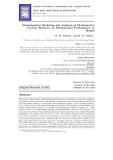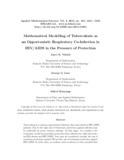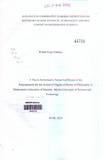| dc.contributor.author | Nathan, O. M. | |
| dc.contributor.author | Jackob, K. O. | |
| dc.date.accessioned | 2022-04-27T06:34:26Z | |
| dc.date.available | 2022-04-27T06:34:26Z | |
| dc.date.issued | 2020-06-20 | |
| dc.identifier.uri | https://doi.org/10.9734/jamcs/2020/v35i430269 | |
| dc.identifier.uri | https://www.journaljamcs.com/index.php/JAMCS/article/view/30269/56792 | |
| dc.identifier.uri | http://ir-library.mmust.ac.ke:8080/xmlui/handle/123456789/2044 | |
| dc.description.abstract | We propose a deterministic model that describes the dynamics of students who have the capabilityWe propose a deterministic model that describes the dynamics of students who have the capabilityto perform well in mathematics examinations and engage in careers that demand its applicationand the negative inuence of individuals with mathematics anxiety on the potential students.Our model is based on SIR classical infectious model classes with Susceptible (S) and Infected (I)taken as Math anxious students (Ax) and Removed (R) adopted as achievers students (Aa) . Themodel is shown to be both epidemiologically and mathematically well posed. In particular, weprove that all solutions of the model are positive and bounded; and that every solution with initialconditions in remains in the set for all time. The existence of unique math anxious-freeand endemic equilibrium points is proved and the basic reproduction number R0 computed usingnext generation matrix approach. A global stability of anxious-free and the endemic equilibria areperformed using Lasselles invariance principle of Lyapunov functions. Sensitivity analysis showsthat achievement rate of potential achievers and achievement rate of math anxious students are the most sensitive parameters. This indicates that effort should be directed towards theseparameters, by having well trained mathematics staff and the best printed and technological resources so as to control the spread of mathematics anxiety. Furthermore, scaling up the understanding level of mathematics algorithms, lowers the mathematics anxiety level and consequently, the spread of mathematics anxiety amongst students reduces. Lastly, some numerical simulations are performed to verify the theoretical analysis result using Matlab software. | en_US |
| dc.language.iso | en | en_US |
| dc.publisher | Journal of Advances in Mathematics and Computer Science | en_US |
| dc.subject | Mathematical, Modeling, Analysis, Mathematics, Anxiety, Behavior, Performance | en_US |
| dc.title | Mathematical Modeling and Analysis of Mathematics Anxiety Behavior on Mathematics Performance in Kenya | en_US |
| dc.type | Article | en_US |




